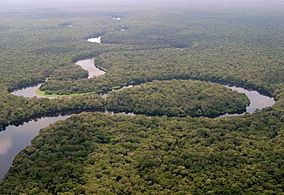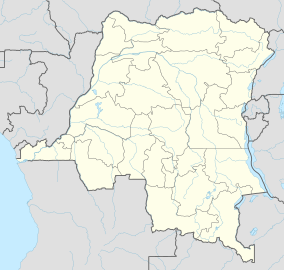Salonga National Park facts for kids
Quick facts for kids Salonga National Park |
|
|---|---|
|
IUCN Category II (National Park)
|
|

View of a river in the Salonga National Park in 2005
|
|
| Location | Democratic Republic of the Congo |
| Area | 36,000 km2 (14,000 sq mi) |
| Established | 1970 |
| Governing body | l'Institut Congolais pour la Conservation de la Nature (ICCN) |
| Type: | Natural |
| Criteria: | vii, x |
| Designated: | 1984 (8th session) |
| Reference #: | 280 |
| Region: | Africa |
| Endangered: | 1999–2021 |
Salonga National Park is a huge national park in the Democratic Republic of the Congo. It is located in the middle of the Congo River basin. This park is Africa's largest tropical rainforest reserve. It covers about 36,000 square kilometers, which is a massive area!
In 1984, the park was added to the UNESCO World Heritage List. This happened because it protects a very large and untouched rainforest. It also provides an important home for many rare animals and plants. For a while, from 1999 to 2021, it was on a list of "endangered" sites. This was due to issues like illegal hunting and building. But thanks to better conservation efforts, it was removed from that list in 2021.
Contents
Exploring Salonga National Park
The park is found in a rainforest area. It is about halfway between Kinshasa, the capital city, and Kisangani. There are no roads inside the park. Most of it can only be reached by river. Some parts of the park are very hard to get to. They have never been fully explored by scientists.
Rivers and Access Points
The southern part of the park is home to the Iyaelima people. You can reach this area using the Lokoro River. This river flows through the center and northern parts of the park. The Lula River helps access the southern areas. The Salonga River also winds its way through the park. It generally flows northwest until it joins the Busira River.
History of the Park
Salonga National Park has an interesting history. It was first created in 1956. Back then, it was called the Tshuapa National Park.
Park Establishment and World Heritage Status
The park got its current borders in 1970. This happened through a special order from President Mobutu Sese Seko. In 1984, UNESCO recognized it as a World Heritage Site. This means it is considered very important globally.
However, a civil war in the country caused problems. Because of this, the park was added to the List of World Heritage in Danger in 1999. This list highlights sites that are at risk. Luckily, the park was removed from this list in 2021. This showed that its protection had improved.
Park Management and Local Communities
Since 2015, the park has been managed by two main groups. These are the Institut Congolais pour la Conservation de la Nature (ICCN) and the World Wide Fund for Nature (WWF). They work together to protect the park.
They also talk a lot with the people who live inside the park. These include the Iyaelima, who are the last people living there. Another group is the Kitawalistes, a religious group. Park guards and the Iyaelima work closely together. Iyaelima villages are even used as guard posts. It's interesting that a type of ape called bonobos are found most often near Iyaelima villages. This shows that these communities help protect the park's animals.
Wildlife and Ecosystems
Salonga National Park is in the middle of the Congo Basin. It protects the largest rainforest in Africa. It is also the second largest rainforest in the world! This huge and complex forest has allowed many unique plants and animals to develop. The park is home to a very diverse and special ecosystem.
Plant Life and Seed Dispersal
Scientists have found 735 different plant species in one part of the park. A large number of these plants, about 85%, need animals to spread their seeds. This process is called zoochory. It shows how important animals are for the forest to grow.
Mammals of Salonga
Many large mammals live in the park. You can find Bongo antelopes, black-crested mangabeys, leopards, and bonobos. The southern part of the park is a key area for studying bonobos in the wild. There are more bonobos near the Iyaelima villages. This is because the Iyaelima people do not harm them. They play a big role in protecting these apes.
Even with some hunting, a healthy number of forest elephants still live in the park. Other mammals you might find include the Dryas monkey, Thollon's red colobus, and different types of pangolins. There are also Angolan slender mongooses, aquatic genets, hippopotamuses, and the African golden cat. Other animals include bushpigs, yellow-backed duikers, sitatungas, okapis, bushbucks, water chevrotains, and forest buffalos.
Bird Species
The park is also home to many different birds. These include the cattle egret, black stork, and yellow-billed stork. The Congo peafowl is a special bird. It is the national bird of the Democratic Republic of the Congo. It is also a threatened species found only in the Congo Basin. This beautiful bird lives in both old and new parts of the forest within the park.
Aquatic Life
Scientists have found 56 types of fish in the park's waters. These include catfishes like Clarias buthupogon and Synodontis nigriventris. You can also find African slender-snouted crocodiles swimming in the rivers.
Sources
- INCEF - Conservation and Health in Salonga
- Wildlife Conservation Society
- UNESCO Salonga National Park Site
- WCMC Site Data Sheet
See also
 In Spanish: Parque nacional Salonga para niños
In Spanish: Parque nacional Salonga para niños


